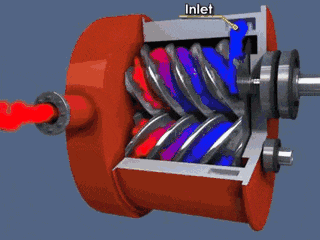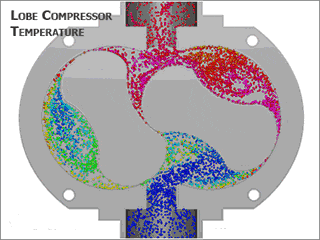Note: The data in this article are for reference only
1. Rotor parts
The rotor component consists of an active rotor (male rotor), a driven rotor (female rotor), main bearing, thrust bearing, bearing gland, balance piston, balance piston sleeve and other parts.
2. General fault phenomena of yin and yang rotors
① Normal mechanical wear and aging
Wear of the outer diameter of the rotor’s yin and yang gear channels;
Normal wear and tear of the rotor cylinder.
② Man-made mechanical damage
Scratches on the outer diameter of the Yin and Yang rotor tooth passages;
Scratches on the rotor cylinder;
The side of the rotor intake and exhaust end covers is scratched;
The wear of the intake and exhaust end bearings and the wear of the inner circle of the bearing end cover;
Wear of the shaft diameter at the rotor bearing location;
The shaft ends of the yin and yang rotors are deformed.
③ General parts that are bruised or stuck
Scratches and jamming (occlusion) between the Yin and Yang rotors;
Between the outer diameter of the rotor and the inner wall of the body;
Between the exhaust end face of the rotor and the exhaust bearing seat;
Between the journal at the suction end of the rotor and the shaft hole of the body;
Between the journal at the exhaust end of the rotor and the shaft hole of the exhaust bearing seat.
3. Cause of failure
① The air filter element is not replaced in time, resulting in poor air intake quality and serious wear of the rotor; the mixed use of lubricating oil of different brands will often lead to contact and wear of the rotor;
②The type of compressor oil used is unqualified or it is not replaced in time as required. The impurities in the oil exceed the standard, causing scratches on the rotor and cylinder;
③ The exhaust temperature is too low during operation, causing the moisture in the oil and gas to be too high. Long-term operation will cause the oil to emulsify, resulting in long-term operation and the inlet and exhaust end bearings will not be effectively lubricated during high-speed and heavy-load rotation. Thermal damage will cause the rotor to string, deform and become stuck;
④Deformation of the rotor drive end shaft head due to the meshing clearance of the drive coupling gear or the failure of the gear key connection;
⑤ Abnormal damage caused by bearing quality.
The above malfunctions of air compressors are generally caused by humans. In daily maintenance work, as long as the operation and maintenance procedures are carefully followed, the above failures can be completely avoided.
In short, the suction and exhaust end journals of the screw compressor rotor are supported by the bearings on the compressor body and exhaust bearing seat respectively. If the coaxiality of the compressor body, exhaust bearing seat, and rotor is due to mechanical processing or assembly, If the design requirements are not met, it will easily lead to scratches between the rotors, the rotor and the body, the rotor and other parts, or the rotor getting stuck. Generally, the coaxiality requirement between the shaft hole and the rotor compression chamber is within 0.01~0.02mm.
The clearance between the parts in the compression chamber of the screw compressor is generally measured in wire or mm. The parts in the compression chamber are dynamically matched. If the designed clearance value is too small, coupled with the error in the manufacturing process, the rotor will easily be damaged. Bruised or stuck. The gap between the rotor and the body is generally about 0.1mm, and the gap between the exhaust end face of the rotor and the exhaust bearing seat is 0.05~0.1mm.
During the disassembly process of the compressor, because the bearing and the rotor shaft are tightly matched, if the disassembly force is too large, it will cause deformation of the parts and the coaxiality of the parts themselves will be reduced.
After the compressor is assembled, it is necessary to check the overall coaxiality of the assembly. If the coaxiality is out of tolerance, it will cause scratches between parts or the rotor will be stuck.
4. Hazards and detection of rotor damage
During normal operation of the air compressor, if abnormal sound, increased vibration, long-term high exhaust temperature, or current overload occurs, it must be shut down for careful inspection. You should focus on checking whether the air compressor bearings are damaged and whether the end of the rotor shaft is deformed.
If damage to the rotor-end bearings can be detected in time and the machine is shut down immediately, the bearings will not become hot and stuck, and large mechanical components will not be damaged.
If the damage to the rotor end bearing cannot be discovered in time and the air compressor is running for a long time, friction and sliding will generally occur between the inner circle of the bearing and the rotor installation bearing position. In severe cases, the rotor bearing position will become blue, roughened and thinned, or the rotor end will appear. The inner circle of the bearing of the cover is stuck, causing the outer circle of the bearing to rotate, causing the bearing hole of the end cover to become enlarged or out of round. It may even happen that the bearing damage directly causes the rotor to deform under the action of high power, destroying the rotor coaxiality.
The inspection of yin and yang rotors generally depends on the wear and scratches of the rotor. Its meshing wear shall not be less than 0.5mm-0.7mm in diameter. The scratched area shall not be greater than 25mm², the depth shall not be greater than 1.5mm, and the non-axiality of the rotor shaft end shall not be greater than 0.010mm.
If you need to purchase the air compressor, our kaishan brand air compressor would be your good choice. Here’s the contact information:
Wendy
E-Mail: wendy@shanxikaishan.com
Phone Number/WhatsApp: +86 18092196185
Post time: Oct-19-2023






